The music industry has always been a stage for bold statements, evolving trends, and the redefinition of cultural norms. Yet, even in 2025, the open embrace of sexuality by female pop artists continues to spark debate. Artists like Sabrina Carpenter and Taylor Swift have found themselves at the center of conversations about empowerment, artistry, and societal double standards. Despite decades of progress in gender equality, the question remains: why is sexual expression still a source of controversy when it comes to women in pop music?
The contemporary age places a higher value on uniqueness and sincerity than at any previous time. Social platforms enhance artists’ opportunities to interact directly with their audience, sidestepping conventional intermediaries. Ideally, this autonomy would enable women to showcase themselves without the apprehension of criticism. Yet, the public’s response to music videos, live shows, and album ideas that include elements of sensuality indicates an ongoing unease. It appears that society approves of women being self-assured and autonomous—up to the point where this self-assurance is expressed through sexuality.
For numerous individuals, the representation of sexuality in music extends beyond mere enjoyment and becomes a means to question entrenched cultural beliefs. When a woman in the music scene opts to present herself as alluring or bold, the focus frequently transitions from her abilities to her ethical standing. While male artists seldom receive equivalent criticism for the same actions, women are met with perceptions that their artistic value is compromised by their sexual portrayal. These perceptions uncover the continuing influence of conventional gender roles, despite pop culture’s assertions of embracing freedom.
Sabrina Carpenter perfectly embodies this intricate relationship. Renowned for her appealing pop tunes and lyrics that connect with many, she has lately added more daring visuals to her projects. Portrait sessions, live shows, and music videos with provocative themes have generated varied opinions on the internet. Some praise her for accepting her maturity as an artist, whereas others ponder if her transformation implies a “loss of innocence.” These responses mirror critiques directed at numerous women before, from Madonna in the 1980s to Britney Spears in the early 2000s.
Taylor Swift faces similar scrutiny, though her approach to sexuality is often more subtle. For years, Swift’s public image revolved around storytelling and emotional vulnerability rather than overt sensuality. However, recent projects suggest a willingness to explore themes of intimacy and physical desire in her music. While many fans embrace this as a sign of artistic maturity, critics are quick to dissect her choices, analyzing lyrics and performances for signs of “pushing boundaries.” The fact that such conversations still dominate headlines illustrates how society continues to wrestle with women who own their sexuality in public spaces.
The feedback that women in the arts encounter isn’t confined to conventional media outlets. Digital platforms enhance each viewpoint, forming echo chambers where discussions on ethics, feminism, and commercial purposes flourish. Just one photo or line can spark prolonged discussion on TikTok, X (previously known as Twitter), and Instagram. Although many of these discussions feature advocates of empowerment, they also reveal the ongoing presence of moral scrutiny. In this digital era, the disparities are amplified, turning every artistic choice into a possible source of contention.
In the past, the music industry has capitalized on appealing imagery, yet it tends to criticize women who engage in it by choice. When a performer opts to portray herself attractively on her terms, the conversation often changes to whether she is “compromising her integrity” or “craving attention.” These critiques ignore that sexuality is not inherently exploitative when it is self-directed. For numerous performers, sensuality is more than just a look; it is a vital component of narrative and emotional expression.
The discourse on sexuality in popular music also aligns with the values of different generations and cultures. Older listeners frequently view provocative visuals as improper or superfluous, whereas younger audiences often consider them a display of self-assurance and genuineness. These generational differences affect the reception, promotion, and analysis of music. The growth of international fan communities adds another layer of complexity, given that cultural standards differ significantly between regions. What is praised in one area might cause anger in another, compelling artists to manage a complicated network of expectations.
It is also important to consider the role of feminism in this debate. Advocates for gender equality argue that policing women’s bodies and choices perpetuates patriarchal norms. From this perspective, when female pop stars embrace sexuality on their own terms, they challenge historical limitations that confined women to roles of purity and passivity. Critics, however, argue that mainstream pop culture often reduces empowerment to sexual display, reinforcing rather than dismantling objectification. This tension underscores why discussions about empowerment in music are rarely straightforward.
Economics cannot be ignored in this conversation. The music industry is a business, and visuals that generate attention often translate into streams, ticket sales, and sponsorships. Some skeptics claim that sexualized imagery is primarily a marketing strategy rather than a statement of autonomy. While commercial motives undoubtedly exist, this assumption undermines artists’ agency. For many, sexuality is an authentic element of their identity, not merely a tool for profit. Disentangling artistic intent from commercial strategy remains one of the thorniest aspects of this debate.
In 2025, with technology altering the way people enjoy music, artists are more visible than at any point before. Apps such as TikTok, YouTube, and Instagram enable audiences to engage with material instantly, turning each fashion choice, song line, or dance routine into a subject for public scrutiny. The contradiction is evident: the public calls for genuine expression from musicians but judges them fiercely when that genuineness disturbs societal norms. This inconsistency subjects female artists to intense scrutiny, compelling them to strike an unattainable balance between being daring yet uncontroversial, alluring yet dignified.
Even in the face of criticism, the ongoing acceptance of female sexuality in pop music highlights a significant cultural transformation. These musicians are not just providing entertainment; they are also participating in discussions about autonomy, identity, and representation. By taking charge of their personas and defying traditional concepts of femininity, they are setting a precedent for future generations to express themselves unapologetically. Although there has been progress, the pushback they encounter shows that achieving true equality in self-expression is still evolving.
The controversy surrounding women like Sabrina Carpenter and Taylor Swift illustrates a broader societal discomfort with the idea of women owning their narratives fully, including their sexual identities. Until public perception moves beyond outdated stereotypes, debates over empowerment versus exploitation will continue to dominate headlines. What remains clear is that these conversations are essential for challenging double standards and fostering a culture that respects individual choice.
Mientras avanza la década, la duda persiste: ¿llegará algún día la sociedad a contemplar la sexualidad femenina en la música pop sin desconfianza ni juicio moral? La respuesta no solo depende de los intérpretes sino también de la disposición del público para enfrentar sus prejuicios. Hasta entonces, cada letra audaz, cada vestuario atrevido y cada actuación sin disculpas continuarán siendo tanto una expresión creativa como un campo de batalla cultural.





